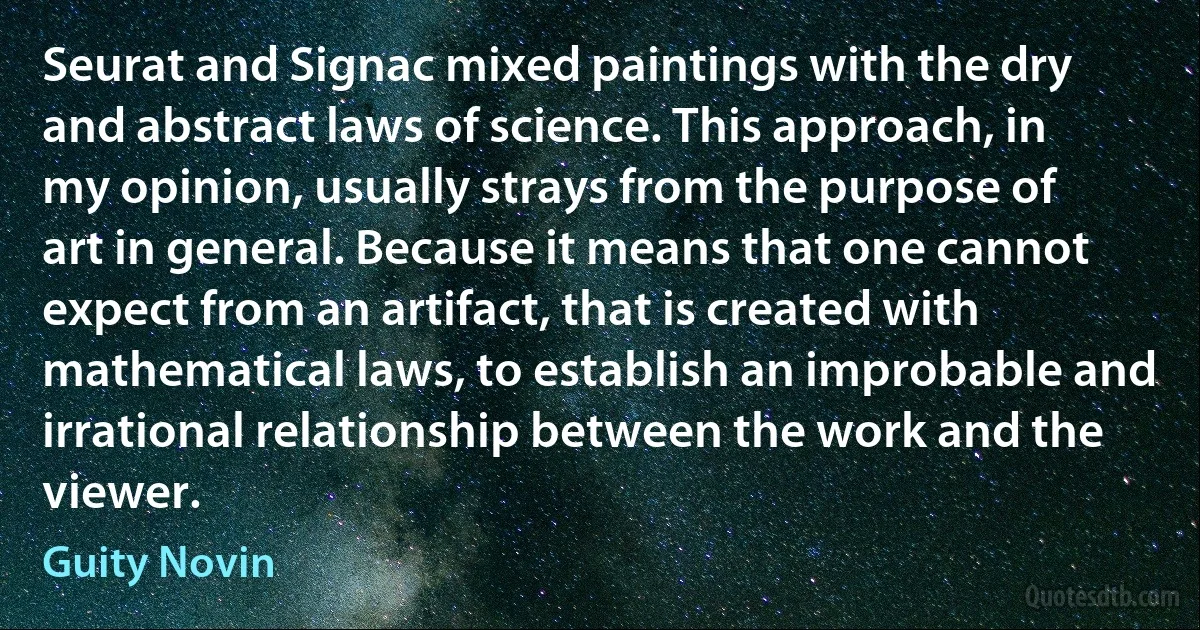Seurat Quotes
Yesterday I had a violent run-in with M. Eugene Manet on the subject of Seurat and Paul Signac. The latter was present, as was Guillaumin. You may be sure I rated Manet roundly. - Which will not please Renoir. - But anyhow, this is the point, I explained to M. Manet, who probably didn't understand anything I said, that Seurat has something new to contribute which these gentlemen, despite their talent, are unable to appreciate, that I am personally convinced of the progressive character of his art and certain that in time it will yield extraordinary results. Besides I am not concerned with the appreciation of artists, no matter whom. I do not accept the snobbish judgments of "romantic impressionists" to whose interest it is to combat new tendencies. I accept the challenge, that's all..

Camille Pissarro
P.S. If you happen to see Seurat or if you write to Signac, tell them that I have tried the mixture of cadmium (well recommended by Contet), with red, white and Veronese green. It becomes black in four or five days from the Veronese green. Even blacker than the chrome yellow mixture. Tell this to Contet.

Camille Pissarro
Your eyes, accustomed to semi-darkness, will soon open to more radiant visions of light. The shadows which we shall paint shall be more luminous than the high-lights of our predecessors, and our pictures, next to those of the museums, will shine like blinding daylight, compared with deepest night. We conclude that painting cannot exist today without divisionism... w:Divisionism - [ Paul Signac initiated divisionism slightly earlier, together with Seurat ] - for the modern painter, must be an innate complementariness which we declare to be essential and necessary.

Umberto Boccioni
I like the heat the tenderness the edible the lusciousness the song of a single person the bathtub full of water to bathe myself beneath the water. I like Ucello, Grunewald, Ingres, the drawings and sketches for paintings of Seurat and that man [=Pablo Picasso ]. I measure all things by weight.

Arshile Gorky
It was during the first years [1906-1910] that we [the Futurist artists] realized the presence of a dualism deep down within us, where another person, whom we ourselves do not know, tends, at the moment of the creative act, to supplant the person we believe ourselves to be and would like to be. It is difficult to bring these two individualities into accord, yet it is upon this accord that the development of a personality largely depends. My first contact with the art of Seurat whom I adopted, once and for all, as my master, did a great deal to help me to express myself in terms of the two simultaneous and often opposed aspirations. This opposition caused me much mental torture, I must admit..

Gino Severini
[Severini characterized his approach to the importance of Divisionism for Futurism as] ..a consequence of Neo-Impressionism (Seurat, Signac) and Van Gogh, Toulouse Lautrec, Degas.. [compared to that of his Milanese colleagues who works were] influenced by Jugendstil [and] a continuation of the Lombardian tradition of Segantini, Previati..

Gino Severini
Signac, definitively won over and who had just modified the paintings 'The Milliner', [1885] and 'Appreteuse et garnisseuse Modes' [exhibited in May 1886], Rue de Caire, p. 174J, following my technique at the same time as I was finishing the 'Jatte'... You'll agree that there's a nuance here and that if I was unknown in [18]85 [ Félix Fénéon did not mention Seurat in his article as leader / initiator of Neo-Impressionism I nonetheless existed, I and my vision that you have described in an impersonal fashion so superbly, aside from one or two insignificant details.

Georges Seurat
Above all, we [the Italian Futurist painters] continue and develop the divisionist principle, but we are not engaged in Divisionism [developed by Seurat and Signac ]. We apply an instinctive complementarism which is not, for us, an acquired technique, but rather a way of seeing things.

Luigi Russolo
The point to be made clear is that, whatever may be our temperament, or our power in the presence of nature, we have to render what we actually see, forgetting everything that appeared before our own time. Which, I think, should enable the artist to express his personality to the full, be it large or small. Now that I am an old man, about seventy, the sensations of colour which produce light give rise to abstractions that prevent me from covering my canvas, and from trying to define the outlines of objects when their points of contact are tenuous and delicate; with the result that my image or picture is incomplete. For another thing, the planes become confused, superimposed; hence Neo-Impressionism (initiated by Seurat and Paul Signac, ed., where everything is outlined in black, an error which must be uncompromisingly rejected. And nature, if consulted, shows us how to achieve this aim.

Paul Cézanne
The final test of painting, theirs, mine, any other, is; does the painter's emotion comes across?.. ..Procedure is the keyword.. ..The difference is that we don't begin with a definite sense of procedure. It's free association from the start to the finished state. The old idea was to make use of your talent. This, we feel, is often to take the line of least resistance.. ..painters like Rothko, Pollock, Still, perhaps in reaction to the tendency to analyze which has dominated painting from Seurat to Albers, associate with very little analysis. A new form of expressionism inevitably followed. With De Kooning the procedure is continual change, and the immediacy of the change. With Jackson, it's the confidence you feel from the concentration of his energy in a given picture.. (1958)

Franz Kline
.. of what use is a painting which does not realize its aesthetical problem? Underlying all sensible works of art, there must be somewhere in evidence the particular problems understood. It was so with those artists of the great past who had the intellectual knowledge of structure upon which to place their emotions. It is this structural beauty that makes the old [clssical] painting valuable. And so it becomes to me a problem. I would rather be sure that I had placed two colors in true relationship to each other than to have exposed a wealth of emotionalism gone wrong in the name of richness of personal expression... The real artists have always been interested in this problem, and you feel it strongly in the work of [Leonardo] Da Vinci, Piero della Francesca, Courbet, Pissarro, Seurat, and Cezanne.

Marsden Hartley
Cubism taught me much and the principle of Pissarro, furthered by Seurat, taught me more. These with Cezanne are the great logicians of color.
No one will ever paint like Cezanne for example, because no one will ever have his peculiar visual gifts; or to put it less dogmatically, will anyone ever appear again with so peculiar and almost unbelievable a faculty for dividing color sensations and making logical realizations of them? Has anyone ever placed his color more reasonably with more of a sense of time and measure than he? I think not, and he furnished for the enthusiast of today new reasons for research into the realm of color for itself.

Marsden Hartley
Delacroix's composition is more entirely created, while that of Seurat employs matter organized scientifically, reproducing, presenting t our eyes objects constructed by scientific means rather than by signs, coming from our feeling. As result there is in his works a positivism, a slightly inert stability, coming from his composition, which is not the result of a creation of the mind, but of a juxtaposition of the objects. It is necessary to cross this barrier to re-feel light, colored and soft, and pure, the noblest pleasure.

Henri Matisse
Once you change the technology - from a film camera to a video camera, or from an 8-mm camera to 16 mm - you change completely the content. With 8 mm, a leaf on a tree will be made up of maybe four grains. So it's very impressionistic, almost like Seurat. If you switch to 16 mm, the technology gives you hundreds of grains on that leaf.

Jonas Mekas
We have never heard Seurat, Cross, Luce, Van de Velde or indeed Van Rysselberghe or Angrand speak of dots. We have never seen them be preoccupied by Pointillism. Read these lines, dictated by Seurat to Jules Christophe, his biographer: 'Art is harmony; harmony is the analogy between opposites and between similar elements of tone, tint and line. By tone I mean light and dark; tint is red and its complementary: green, orange and its complementary: blue, yellow and its complementary: purple.. .The method of expression relies on the optical mixture of tones, tints and their reactions (shadows that follow very strict rules).

Paul Signac
..it [the large painting 'Bathers at Asnieres', by Georges Seurat was painted in great flat strokes, brushed one over the other, fed by a palette composed, like Delacroix's, of pure and earthy colors. By means of these ochres and browns the picture is deadened, and appears less brilliant than those the impressionists paint with a palette limited to prismatic colors. But the understanding of the laws of contrast, the methodical separation of elements - light, shade, local color, and the interaction of colors - and their proper balance and proportion, give this canvas its perfect harmony.

Paul Signac
![I saw Guillaumin. We went to look at my two latest paintings which were bought by Durand. All he said was 'there's no firmness in the foreground'. It was evening, we were seeing the paintings by gas-light, which neutralized the orange tones. As Seurat says, what they [the Impressionists]] look for is thick impasto; but at Clauzet's I saw a Guillaumin, also in the evening, and it looked made of tar, so much shellac was used at the base of this painting, which in my view is really old stuff; it must be admitted that he made an effort to tighten the design but then the harmonies are insignificant and lack logic - there is no drawing, there is a flurry of colors, but no modeling; it is one step from [w: Jules Dupré|Jules Dupreé]] - modernized. (Camille Pissarro)](https://cdn.quotesdtb.com/img/quotes_images_webp/96/camille-pissarro-base-bought-428896.webp)

![.. at least I have the conviction of being honest and I do despise most of all those.... alienating works of art [eg. of Seurat ], the disease of our time. (translation from original Dutch: Fons Heijnsbroek) (Willem Roelofs)](https://cdn.quotesdtb.com/img/quotes_images_webp/05/willem-roelofs-art-conviction-960205.webp)
